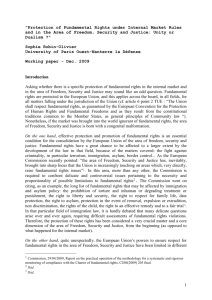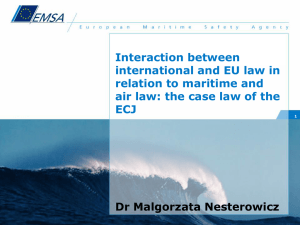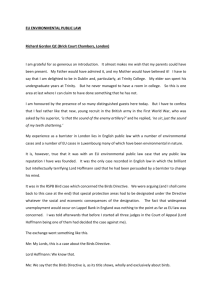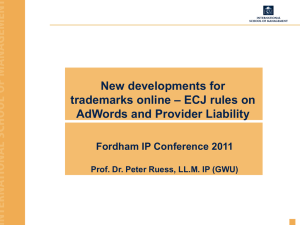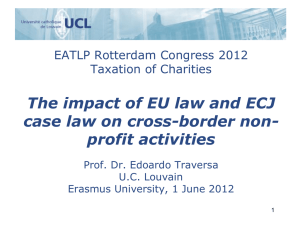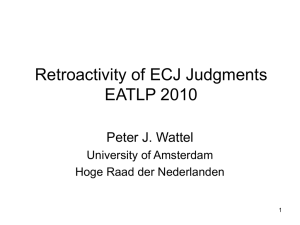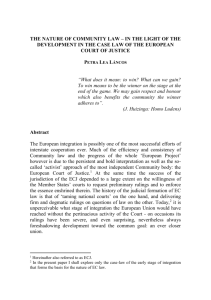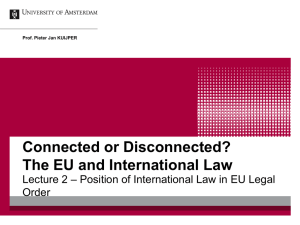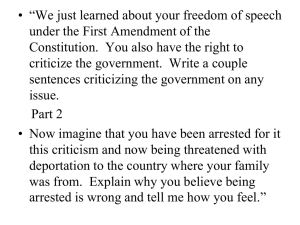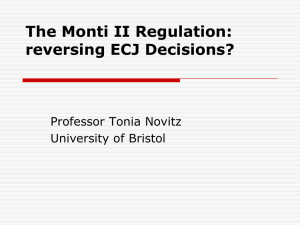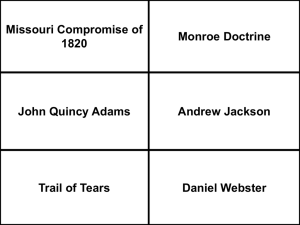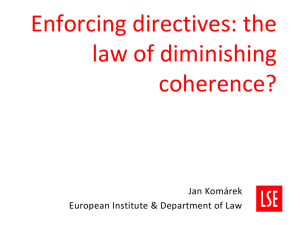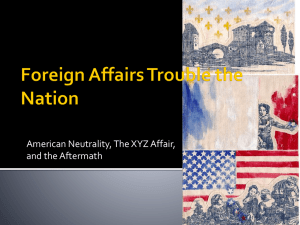Direct Effect as a Means of the Enforcement of EU law through
advertisement
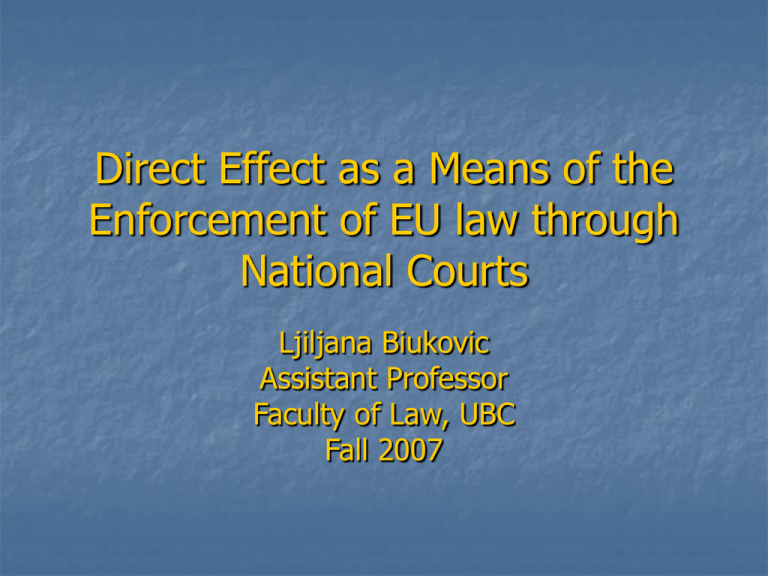
Direct Effect as a Means of the Enforcement of EU law through National Courts Ljiljana Biukovic Assistant Professor Faculty of Law, UBC Fall 2007 Starting point – Direct Effect of the Treaty: Van Gend en Loos (case 26/62) The question referred to the ECJ (on the basis of ex Art. 177 now Art. 234) by a Dutch court (Tafiefcommissie) was: whether a Dutch person could claim before a Dutch court the protection of his rights conferred on him by the provision of the Treaty of Rome (ex. Art. 12) The case arose out of a claim submitted by a private party to a national court Another means of enforcing the EU law (or compliance with the Treaty) was for an importer to inform the Commission to take necessary legal actions against The Netherlands for if failure to comply with the EU law Important: the Treaty does not have a provision on direct effect of the EC law but the ECJ deduced it from “the spirit, the general scheme and the wording” of the Treaty Test: ECJ held that ex Art. 12 was clear, unconditional and not dependent upon any further implementation at the national level – thus capable of having direct effect Development of the Doctrine of Direct Effect: Defrenne v. Sabena (case 43/75) 1. 2. 3. 4. Develops the doctrine further by examining its effects and establishing that the Treaty provisions could have both vertical (proceedings against a Member State) and horizontal (proceedings against another private party) direct effect The question referred to the ECJ by a Belgian Court was whether a female air steward could rely on Article 141 of the Treaty (requiring every Member State to ensure equal pay for men and women) in her claim to have the same salary and pension payments as male retired air stewards of the same company (Sabena) Important: ECJ had to use the same test as in Van Gend en Loos to find if the Treaty provision was capable of having direct effect If applied strictly, the test would not find Article 141 neither clear nor unconditional and some further actions by Belgium were needed to clarify measures needed to abolish discrimination [para. 19] ECJ then relaxed the test asking only for a provision to be sufficiently precise and unconditional to be invoked in national courts – the issue is one of justiciability (according to a former ECJ judge Pescatore) ECJ introduced the concept of horizontal direct effect of the Treaty - the case involved two private parties (SABENA was not seen as a public/government agent) and acknowledged direct effect of the Treaty in the context of legal proceedings against a private party Direct Effect of Directives: Van Duyn v. Home Office (case 41/74) Ms. Van Duyn, a Dutch national and a member of the Church of Scientology, challenged the UK ban on foreign scientologist entering UK as being contrary to EC Directive 64/221 ECJ considered if the Directive was capable of having direct effect and held: “ 12… where the Community authorities have, by Directive, imposed on MSs the obligation to pursue a particular course of conduct, the useful effect of such an act would be weakened if individuals were prevented from relying on it before their national courts … It is necessary to examine, in every case, whether the nature, general scheme and wording of the provisions in question are capable of having direct effect on the relations between MSs and individuals.” Direct Effect and Estoppel: Ratti (case 148/78) Ratti challenged related national law by relying on two EC Directives not implemented in Italy arguing that Italy could not be able to benefit from its own failure to fulfill its Treaty obligations (estoppel) – case of vertical direct effect ECJ made important ruling that directives could be directly effective only when the MSs fail to implement them correctly and timely Horizontal Direct Effect and Directives: Marshall (case 152/84) Ms. Marshall, a 62-year old women working for UK health authority dismissed as a result of her age, challenged a decision as contrary to the EC Equal Directive ECJ denied horizontal direct effect to directives but since Marshall was an employee of a public health authority she was able to rely on vertical direct effect of a directive Important: decision criticized for not really explaining how were public health authorities liable for transposing the Equal Pay Directive into national law even if they are considered to be public entity) Indirect Direct Effect: Von Colson (case 14/83) Von Colson and Kamann who were refused employment in a male prison because of their gender, challenged German law that did not allow for them to receive full damages for discrimination (but only travel costs) on the basis of the Equal Treatment Directive Directive held not to be directly effective due to lack of clarity and unconditionality (does not provide a specific sanction and remedy in case of discrimination but leaves it to Member States to decide on any specific form of sanctions for unlawful discrimination) ECJ held that Directive could have indirect direct effect doctrine holding that “it is for the national court of interpret and apply legislation adopted for implementation of the directive in conformity with the requirements of Community law” but held also that “compensation in any event be adequate in relation to the damage sustained…” - nominal compensation would not be adequate ECJ used indirect effect doctrine to impose a duty of consistent interpretation of national laws with EC laws on national courts Limits of Indirect Direct Effect: Marleasing (case C-106/89) Advocate General Van Gerven’s Opinion para 8: “The obligation to interpret a provision of national law in conformity with a directive arises whenever the provision in question is to any extent open to interpretation … The obligation to give an interpretation in conformity with a directive is…restricted by Community law itself, of which the directive forms part, and in particular by the principles of legal certainty and non-retroactivity which also form part of Community law…” ECJ para 8: “It follows that, in applying national law, whether the provisions in question were adopted before or after the Directive, the national court called upon to interpret it is required to do so, as far as possible, in the light of the wording and the purpose of the Directive in order to achieve the result pursued by the latter and thereby comply with the third paragraph of Article 189 [now 249] of the Treaty” Conclusion: decision strengthens duty of consistent interpretation suggesting that all national legislation should be interpreted in the light of EC law (prior and subsequent to the relevant EC law) in particular if the national provision is vague and ambiguous Origins of State Liability and Direct Effect Factortame (case C-213/89): House of Lords asked ECJ whether, notwithstanding that rule of national law, English courts had the power, under EC law, to grant an interim injunction against the Crown and the ECJ held that: 19. In accordance with the case-law of the Court, it is for the national courts, in application of the principle of cooperation laid down in Article 5 of the EEC Treaty, to ensure the legal protection which persons derive from the direct effect of provisions of Community law 21. … the full effectiveness of Community law would be … impaired if a rule of national law could prevent a court (seized of a dispute governed by Community law) from granting interim relief in order to ensure the full effectiveness of the judgment to be given on the existence of the rights claimed under Community law . It follows that a court which in those circumstances would grant interim relief, if it were not for a rule of national law, is obliged to set aside that rule . 23. Consequently, the reply to the question raised should be that Community law must be interpreted as meaning that a national court which, in a case before it concerning Community law, considers that the sole obstacle which precludes it from granting interim relief is a rule of national law must set aside that rule . “ Francovich (joined cases C-6 & 9/90) 1. The Italian Court asked ECJ important questions regarding the Member State’s liability to pay damages to its nationals for failure to implement a directive ECJ held: Regarding direct effect of a directive: “12. It is … necessary to see whether the provisions of Directive 80/987 are unconditional and sufficiently precise. There are three points to be considered: the identity of the persons entitled to the guarantee provided, the content of that guarantee and the identity of the person liable to provide the guarantee… 26. [e]ven though the provisions of the directive in question are sufficiently precise and unconditional as regards the determination of the persons entitled to the guarantee and as regards the content of that guarantee …[t]hose provisions do not identify the person liable to provide the guarantee, and the State cannot be considered liable on the sole ground that it has failed to take transposition measures within the prescribed period. Francovich (joined cases C-6 & 9/90) 2. 3. Regarding Member State’s liability: “33. The full effectiveness of Community rules would be impaired and the protection of the rights which they grant would be weakened if individuals were unable to obtain redress when their rights are infringed by a breach of Community law for which a Member State can be held responsible. (reference to individual rights) 35 … a State must be liable for loss and damage caused to individuals as a result of breaches of Community law for which the State can be held responsible is inherent in the system of the Treaty (principle of state liability embedded in the EC law) 36 A further basis for the obligation of Member States to make good such loss and damage is to be found in Article 5 of the Treaty, under which the Member States are required to take all appropriate measures, whether general or particular, to ensure fulfilment of their obligations under Community law. Among these is the obligation to nullify the unlawful consequences of a breach of Community law (see, in relation to the analogous provision of Article 86 of the ECSC Treaty, the judgment in Case 6/60 Humblet v Belgium [1960] ECR 559). Regarding the conditions of MS’s liability: “40. The first of those conditions is that the result prescribed by the directive should entail the grant of rights to individuals. The second condition is that it should be possible to identify the content of those rights on the basis of the provisions of the directive. Finally, the third condition is the existence of a causal link between the breach of the State' s obligation and the loss and damage suffered by the injured parties. CONCLUSION: ECJ established MS’s liability for breach of EC law (failure to implement a directive) even though a directive was not found to have full direct effect State Liability beyond Direct Effect of Directives: Brasserie du Pêcheur (joined cases C46 &48/93) ECJ applied modified the 3 condition test given in Francovich to cases of MS liability in damages for breaches not stemming from failure to implement a directive: “74. …[W]here a breach of Community law by a Member State is attributable to the national legislature acting in a field in which it has a wide discretion to make legislative choices, individuals suffering loss or injury thereby are entitled to reparation where (1)the rule of Community law breached is intended to confer rights upon them, (2) the breach is sufficiently serious and (3.) there is a direct causal link between the breach and the damage sustained by the individuals....The possibility of making reparation conditional upon the existence of fault (third question in Case C-46/93)”


